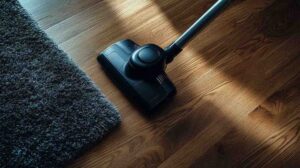Pool days are the best, right? A clear, sparkling pool is inviting, but a pool full of leaves and dirt? Not so much. That’s where your trusty pool vacuum comes in! It’s an essential tool for keeping your water clean and ready for a swim. But sometimes, you might find yourself asking, how to get vacuum pool suction?
It can be frustrating when your vacuum isn’t working as it should, leaving you with a half-cleaned pool. Don’t worry, you’re not alone! Many pool owners face this common challenge. The good news is, getting your pool vacuum to suck up all that debris effectively usually comes down to a few simple checks and adjustments. Think of it like this: your pool vacuum needs a clear path and a strong “breath” to do its job. If air gets in or something blocks the way, the suction weakens. We’re here to guide you through the process of getting your manual pool vacuum working perfectly.
So you can enjoy a spotless pool without the headache. Let’s dive in and get that suction strong.
Table of Contents
When I Need to Do Pool Vacuum Suction
You should vacuum your pool whenever you see dirt, leaves, or debris on the bottom. If the water looks cloudy or algae start to form, it’s time to vacuum. Regular vacuuming helps keep your pool clean and prevents damage to the filter. After storms or heavy use, vacuuming removes extra debris that might clog the system. Also, if you notice your pump pressure rising, vacuuming can help clear the filter and improve water flow. Doing this keeps your pool safe and ready for swimming.
Tools You Need
To use vacuum pool suction properly, gather these simple tools:
- Vacuum head – attaches to the pole and cleans the pool floor.
- Telescopic pole – helps you reach every corner of the pool.
- Vacuum hose – long enough to connect the vacuum head to the skimmer.
- Skim vacuum plate – fits over the skimmer basket to trap debris.
- Pool filter system – keeps suction strong and water clean.
With these tools, manual pool vacuuming becomes quick and easy even for beginners.
Set Up Pool Vacuum Suction
Manually vacuuming your pool starts with setting up the equipment the right way. This process is simple and doesn’t take much time. Just follow the steps below, and you’ll have your pool vacuum ready to go in minutes.
Connect the Vacuum Head to the Pole
Begin by snapping the vacuum head onto the telescopic pole. This long pole lets you guide the vacuum across the pool floor without getting in the water. Make sure it’s locked in tight, so it won’t come loose while cleaning.
Attach the Hose to the Vacuum Head
Now take one end of the vacuum hose and connect it to the top of the vacuum head. Push it in firmly. This hose will carry water and debris from the pool to your filtration system.
The hose must be long enough to reach every corner of the pool.
Fill the Hose with Water
Before creating suction, you need to get all the air out of the hose. Here’s how:
1. Submerge the vacuum head, pole, and hose into the pool.
2. Hold the free end of the hose over a return jet.
3. Wait for bubbles to rise from the vacuum head.
4. Once the bubbles stop, the hose is full of water.
Now that the hose is full of water, it’s time to connect it to the skimmer. This is where the suction begins. You have two ways to do it:
This step is key for strong pool vacuum suction.
Connect the Hose to the Skimmer

1. Using a Skim Vacuum Plate
Place the skim vacuum plate onto the hose end. Keep the hose underwater so air doesn’t get in. Cover the opening with your hand as you move it to the skimmer basket. Then, gently place it over the basket.
This helps keep debris from getting into your pump.
2. Without a Skim Vacuum Plate
No plate? No problem. First, remove the skimmer basket. Keep the hose full of water. Cover the hose end with your hand, then insert it directly into the suction hole at the bottom of the skimmer.
Important: Make sure all the connections are tight. If there’s any air leak, the pool vacuum suction will weaken.
Confirm Suction Power
You’re almost done! Now, check if the vacuum is pulling water and debris as it should.
1. Place your hand near the vacuum head.
2. You should feel a light pull on your palm.
If it’s not working well, try this:
1. Look for air bubbles in the hose. If you see any, there’s air inside.
2. Double-check all your connections.
3. Make sure the pool filter system is running properly.
A strong, steady pool suction hose flow means you’ve set it up right.
Bonus Tips for Better Results:
1. Always prime the hose before starting. This means filling it fully with water.
2. Clean slowly. Use overlapping passes with the vacuum.
3. If the vacuum head sticks to the floor, turn off the pump for a few seconds.
This helps release pressure and resets the flow. With this setup, you’re ready to enjoy a clean, clear pool. Manual pool vacuuming might feel old-school, but when done right, it gives great results. And best of all? It protects your pool cleaning system and keeps your water crystal clear.
Fix Weak or No Suction
Weak or no suction is a common issue, but the fix is often simple. Here’s a step-by-step guide to help you solve it fast.
1. Check the Water Level
Make sure your pool’s water is halfway up the skimmer opening. If it’s too low, air can enter the system, causing suction loss.
2. Clear the Skimmer Basket
Turn off the pump and remove the skimmer basket. Empty out leaves, bugs, and other debris. A clogged skimmer cuts off water flow to your vacuum.
3. Inspect the Vacuum Hose
Your pool vacuum hose should be filled with water before use. If there’s air inside, it can break suction. Submerge the hose in the pool to remove all air bubbles.
4. Look for Air Leaks
Check the hose connections, the pump lid, and the O-rings. If you see bubbles in the return jet, there may be an air leak. A leak on the suction side of the pump is often the cause.
5. Clean the Pump Basket
Turn off the pump and open the lid. Take out any dirt or debris from the pump strainer basket. Rinse it well and secure the lid tightly.
6. Backwash or Clean the Filter
A dirty filter slows water flow. If you have a sand filter, backwash it, and if you are using a cartridge filter, remove it and wash it. This step helps restore strong suction.
7. Reset the Hose and Vacuum Head
Sometimes the vacuum head gets stuck to the pool floor. If that happens, turn off the pump for a second. This will release the pressure and let you move it again.
Bonus Tip:
Always keep the hose underwater while connecting it. This stops air from getting in and keeps your suction strong.
With these steps, you now know exactly how to get vacuum pool suction working again. It’s all about checking the basics: water flow, air leaks, and clean filters. With a few simple fixes, your vacuum will be back to full power in no time.
Tips for Better Suction and Cleaning
Keeping your manual pool vacuum working at full strength doesn’t need to be hard. Just follow these easy steps to improve suction and get a cleaner pool fast.
1. Prime the Hose Every Time
Before starting, always fill the vacuum hose fully with water. This pushes air out and helps your vacuum pull better. If air gets inside, suction drops fast.
2. Move Slowly and Steadily
Rushing can stir up dirt instead of collecting it. Move the vacuum slowly in overlapping rows. This gives better coverage and stronger suction.
3. Clean the Filter First
A clogged filter blocks water flow. Before vacuuming, backwash your sand filter or rinse your cartridge filter. Clear filters boost suction and protect your pump.
4. Check the Hose for Cracks
Even small splits in the vacuum hose can let air in. Hold the hose underwater and look for bubbles. If you spot leaks, replace the hose section.
5. Seal All Connections Tight
Loose parts cause weak suction. Push all parts together firmly. Focus on the hose, vacuum head, and skimmer plate. Tight connections keep airflow strong.
6. Brush First, Vacuum After
Brushing the walls and steps before vacuuming helps loosen dirt and algae. This gives the vacuum more to clean and prevents stuff from settling again.
7. Adjust Water Flow if Needed
If the vacuum sticks to the pool floor, your flow may be too strong. You can partly close a valve to reduce suction or turn the pump off for a second to reset.
By following these simple steps, you’ll get strong pool vacuum suction and a cleaner pool every time. A few small checks can make a big difference—saving time, protecting your gear, and keeping your water sparkling clean.
What to Do After Vacuuming Your Pool
Vacuuming your pool is only half the job—what you do afterward is just as important to keep your water safe and clear. Here’s a simple step-by-step guide on what to do next:
Step 1: Turn Off the Pump
Once you’re done vacuuming, turn off the pool pump before removing anything. This keeps debris from flowing back into the pool when you disconnect the hose.
Step 2: Disconnect and Store Equipment
Carefully remove the vacuum head, hose, and telescopic pole from the water. Drain the water from the hose and hang it up to dry. Rinse everything with clean water and store it out of direct sunlight to prevent wear and tear.
Step 3: Clean Out the Skimmer and Pump Basket
Take out any leaves, dirt, or debris that may have collected during vacuuming. Empty the skimmer basket and check the pump basket too. This keeps your system from clogging and helps with smooth water flow.
Step 4: Backwash or Rinse the Filter (If Needed)
If you’ve vacuumed a lot of debris or the water was very cloudy, it’s a good idea to backwash your sand filter or rinse your cartridge filter. This keeps suction strong and ensures clean water circulation.
Step 5: Check Water Levels
After vacuuming, your pool might lose a bit of water. Make sure the water level is midway up the skimmer. If it’s low, top it off with fresh water to prevent air from entering the system.
Step 6: Test and Balance Your Pool Water
Use a pool test kit to check chlorine, pH, and alkalinity. Vacuuming may stir up hidden debris or algae, so always test after cleaning. Add chemicals if needed to keep your water safe and clear.
Step 7: Run the Filter System
Let the pool pump run for at least 1–2 hours after vacuuming. This helps filter out fine particles still floating in the water and allows your system to settle.
Final Tip:
Make this routine a habit! Regular pool maintenance keeps your pool crystal clear and extends the life of your vacuum system.
Which part should I avoid?
1. Skipping air removal (not priming the hose)
2. Not creating a tight seal at the skimmer
3. Vacuuming too fast
4. Ignoring correct filter settings
5. Not monitoring filter pressure
6. Letting the vacuum head get stuck
7. Skipping equipment cleaning after use.
FAQ
Can I use the vacuum without a skim vacuum plate?
Yes. Remove the skimmer basket and insert the hose straight into the suction hole. Just keep the hose full of water to avoid air entering.
How do I fill the vacuum hose with water?
Submerge the vacuum in the pool. Hold the free end over a return jet until all bubbles stop. This primes the hose for strong suction.
Why does the vacuum head stick to the pool floor?
It sticks when suction is too strong. Turn off the pump for a few seconds to release pressure, then restart.
How can I tell if my pool vacuum has strong suction?
Place your hand near the vacuum head. You should feel a steady pull. No pull? Recheck the setup and filter system.
Final Thought
A sparkling pool is one of life’s simple joys, but it takes a little know-how to keep it that way. If you’ve ever wondered how to get vacuum pool suction just right, you’re not alone. Many pool owners run into the same issue, and the fix is often easier than it seems.
By making sure the hose is full of water, checking for air leaks, and keeping your filter clean, your manual vacuum will run smoothly. These small steps go a long way in getting strong suction and spotless results. It’s all about consistency and care.
Don’t rush the process. Take a few extra minutes to check your setup. Prime the hose, tighten connections, and move the vacuum slowly across the pool floor. These simple habits will save time, protect your equipment, and keep your pool water fresh and clear.
Think of pool care like brushing your teeth—do it often, do it right, and problems won’t build up. If you pay a little attention now, you’ll have less work to do later. With the right tools, clear instructions, and some practice, pool vacuuming becomes quick, easy, and effective.
So next time your pool needs a clean, you’ll be ready—with strong suction, a smart routine, and the confidence to do it right.

Welcome to Homenias, I’m Jaman M, and I’m here to help you discover the best home products. With years of experience, they offer genuine reviews and helpful guides. Their mission is to make your choices easier. It’s organizing your space or finding creative solutions. Explore how the right products can enhance your everyday life. Don’t miss out on finding the best home products to raise your living experience.





